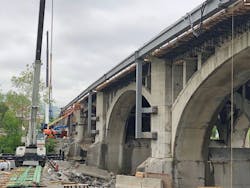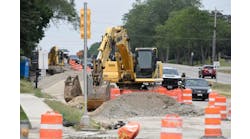I-74 Mississippi River Bridge, Bettendorf/Davenport, Iowa, and Moline, Ill.: This $1.2 billion project has now begun, and the project timeline looks to make major progress before the weather turns icy at year’s end. Within the river, all 279 drilled shafts will be completed and the westbound bridge piers and roadway will take shape. In Bettendorf, steel will be set across the piers, forming the WB roadway and exit ramp. Fourteenth Street, along with the existing ramp to WB I-74, will be reconstructed and thus reduced to one lane through summer’s end. The riverfront embankment on the Moline side will see paving, and 19th Street will be reconstructed in advance of steel coming through for the bridge itself, as that street will have to serve local traffic to downtown Bettendorf and Moline in the coming year. Traffic pattern shifts began this past April, with speed reductions and minor detours.
I-4 Ultimate, Orlando, Fla.: Florida’s largest road project continues to progress since our visit to the work site last year. The $2.3 billion P3, which stretches 21 miles from Orange County to Seminole County, is just over two years into a nearly seven-year construction schedule, and much progress has been made. In the Maitland area, Big Drive construction crews have moved nearly all the ramps at that interchange. Construction in Maitland is scheduled to be complete in 2018. In downtown Orlando, the critical path work at the I-4/S.R. 408 interchange continues to take shape, with progress on the foundations and substructure work for the S.R. 408 bridges and the new flyover ramps. Hurricane Matthew caused a brief shutdown in late 2016, but crews were able to bounce back, and the project timeline has been maintained. Ramp closures will proceed in 2018, as will eastbound I-4 mainline reconstruction.
Penn Street Bridge, Reading/West Reading, Pa.: This project is a crucial one for the community of greater Reading. The bridge is a primary artery connecting the two towns (34,000 VPD), a fact that was at the forefront of PennDOT’s thinking when planning the project. Traffic has been kept flowing with only minimal lane reductions. Crews are presently rehabilitating historic arches and concrete lattice work, and building outlooks where pedestrians can stand and look at the Schuylkill River below. Work began in December 2016 to rehabilitate the 27-span concrete arch bridge. J.D. Eckman Inc. is currently completing rehabilitation of the north side, then later this summer will shift to the south side. The $42.5 million project is scheduled to be completed in December 2019. When completed, the new bridge will have a bicycle lane and pedestrian sidewalk on both sides.
I-15 “Technology Corridor,” Silicon Slopes, Utah: The Utah Department of Transportation (UDOT) is widening I-15 in the heart of one of the fastest-growing areas of the state—Silicon Slopes. This is the last remaining section of I-15 between Salt Lake City and Spanish Fork where the freeway is still only four lanes wide. Crews started construction of the $430 million project in late April of this year. UDOT will widen I-15 in Utah County with two new lanes in each direction from Lehi Main Street to S.R. 92. The design builder is currently busy constructing a new frontage road system to alleviate east-west congestion in this busy area. In addition, UDOT will build a new bridge at Triumph Boulevard and perform the complete reconstruction of two freeway interchanges at 2100 North and S.R. 92. The project is scheduled for completion in late 2020.
Bayonne Bridge, Staten Island, N.Y., and Bayonne, N.J.: This iconic East Coast bridge carries 3.5 million VPD and is one of only four crossings connecting N.J. to Staten Island. There is a no-closure rule on this project. The arch roadway is being replaced with a wider roadway along with two new decks with new supporting piers. The deck is being widened from four 10-ft lanes to four 12-ft lanes with a concrete median barrier and 5-ft shoulders. The navigational clearance portion of the work—which raised the roadway to 215 ft above mean water height—is complete. Additional work will include on-grade roadway construction including curbs, carriers, asphalt paving, and furnishing and installation of traffic-control devices. Residential homes are located within 20 ft of the work site, which presented contractors with distinct challenges; however, approach piers were placed within the existing right-of-way to avoid property annexation.
Louisiana I-10 (multiple contracts): I-10 is being widened from four to six lanes between Highland Road in East Baton Rouge Parish and S.R. 73 in Ascension Parish. This 6.5-mile segment is a major commercial/commuter route and carries over 95,000 VPD. James Construction Group LLC is performing the work on the $72 million design-build project, which began in February 2018 and is expected to be complete in the spring of 2020. Current work includes moving dirt, laying drainage pipe, forming footings and pouring concrete for the footings. Beginning in May 2018 and lasting throughout the summer, the S.R. 928 (Bluff Road) overpass will be closed to repair a damaged girder and to raise the bridge to meet updated interstate standards. The bridge is expected to reopen before school begins in the fall. Near the end of 2018 and into 2019, the two I-10 bridges over Highland Road will be replaced with one larger bridge to hold all traffic lanes.
I-696 between I-94 and I-75, Macomb County, Mich.: A full closure is always treacherous ground for a DOT, but in the case of a crucial portion of Michigan’s massive interstate construction project it is the most efficient means of progressing according to the needed timeline. I-696 in Macomb County is a crucial artery between I-94 and I-75 that carries 150,000 VPD. An investment of $90 million will remove and replace all the concrete on both eastbound and westbound I-696 between the interstates. Westbound I-696 will be closed during the work, with traffic detoured throughout the entire project. Eastbound I-696 traffic will retain access, although traffic will be shifted throughout the project. Closing one direction of the freeway, according to the Michigan DOT, provides a safer work zone for construction crews and drivers. As of this writing, 4,000 ft of pavement has been removed; storm sewer inspection has begun; and new pavement will begin before month’s end.
U.S. 95 (Phase 2B/5), Las Vegas: This $78 million widening and upgrade to six miles of U.S. 95 between Ann and Kyle Canyon roads in northwest Vegas aims to relieve congestion, improve efficiency and enhance safety for this rapidly growing section of Sin City. At present, this stretch suffers under 52,000 VPD, and estimates have traffic doubling within the next 20 years. The project calls for expanding the highway from four to six lanes from Durango Drive to Kyle Canyon Road, constructing Elkhorn Road carpool access ramps and building a diverging diamond interchange at Kyle Canyon Road that temporarily shifts traffic to the left side of the road, thereby keeping traffic flowing through two pairs of unimpeded left turns onto and off the freeway. ITS, signage, barrier rail and box storm drainage are among the other enhancements on the docket; all told, this project will move enough dirt to fill more than 300 Olympic-size swimming pools.
I-15/U.S. 93 Garnet Interchange, Clark County, Nev.: This $58 million project calls for building a modified diverging diamond interchange (the existing interchange was built in 1963), plus widening U.S. Highway 93 from a two-lane highway to a four-lane divided highway for five miles, extending from the Garnet Interchange to just north of Apex Power Parkway. There also will be a two-lane frontage road parallel to U.S. Highway 93 with a partial interchange at Grand Valley Parkway; additionally, it will be designed for future traffic signals at U.S. Highway 93/Apex Great Basin Way. Meanwhile, I-15 will be prepped for a future widening to six lanes. The project will improve safety and enhance mobility for both I-15 and U.S. Highway 93. This corridor served as a vital alternate route during the 2014 Moapa floods that washed out and briefly closed a section of I-15.



